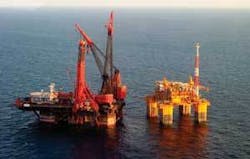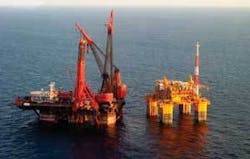Louisiana staying competitive in attracting energy investment
Despite the state’s legacy in the energy industry, Louisiana is not standing still. The state has created a variety of incentive programs designed to stimulate new discoveries and deep drilling initiatives.
Dane E. Revette, Louisiana Dept. of Economic Development, Baton Rouge, La.
A hub of the oil and gas industry, Louisiana makes considerable contributions to the nation’s energy supply. From pipeline infrastructure to enhanced oil recovery, to LNG imports, gas storage facilities and pet–coke fueled gasification plants, Louisiana continues to move forward with a balanced approach to conserving and supporting our most important industry sector.
Louisiana ranks first in overall crude oil production and second in terms of natural gas production, when considering the offshore areas of the Gulf of Mexico. Staying competitive in the energy industry remains a priority for the state. Louisiana understands that capital is mobile, both domestically and internationally, and producers from integrated majors and independents have investment options for their exploration and production dollars.
Infrastructure development
Louisiana is seeing continued infrastructure development, such as the installation of new East–West pipelines. These are helping to facilitate the development of shale gas and cotton valley gas in the northern part of the state.
In central Louisiana, oil recovery efforts have been accelerating, resulting largely from the extension of Denbury Resources’ carbon dioxide (CO2) pipeline system. Denbury’s CO2 delivery system will eventually extend into other parts of the state to enhance production. With several gasification projects focusing on petrochemical processing, CO2 is also expected to be made available for the coastal fields.
In addition to the CO2 delivery infrastructure development, Denbury has announced agreements to purchase anthropogenic CO2 (manmade CO2) from both power plants and petrochemical facilities in Louisiana, assisting both upstream and downstream energy sectors. As oil production from the region’s fields declines, Louisiana is working to secure a revenue stream to support CO2 sequestration – both key factors for new independent oil and gas companies looking to invest. With access to CO2, smaller companies that move quickly are positioned to take full advantage of the state’s unique infrastructure.
A massive amount of supporting infrastructure has been developed in Louisiana over the past century. Pipelines, refineries, gas processing facilities, platform fabrication yards, ports, and supply bases are just a few of the other areas that further distinguish the state. These assets have led Louisiana to become an energy hub historically linking the Gulf Coast with the rest of the United States and, increasingly, with the world.
Opportunity abounds
Despite Louisiana’s legacy in the energy industry, there are still considerable opportunities to develop the state’s production base. Since 2002, Louisiana has seen a continued rise in new drilling permits. The state’s income from oil and gas royalties hit a new record of $522.5 million for 2006–2007, while its total income from bonus leaseholder and interest payments was more than $600 million – the highest since 1983.
North–central Louisiana is enjoying record highs in drilling activity. Many new drilling and service companies are moving into the area in hopes of exploiting shale gas and cotton valley gas. Drilling rigs are in short supply and seem to move every few weeks to a new site location. For the onshore companies that can keep up with the demand, opportunities appear to be plentiful.
While coastal Louisiana has not seen a return to record high activity, drilling permits have been holding steady at almost 100 each year. “You can look for oil anywhere, but you can count on finding it in South Louisiana,” one geologist commented.
The majority of southern Louisiana and the coastal areas have been completely overlaid with 3–D seismic shoots. The degree of coverage of the latest technology adds to the likelihood of additional activity in the future. And, given the steady development on the CO2 infrastructure and the advancement of technology in this area, Louisiana anticipates a bright future for some older production areas.
The outlook for deepwater resources also remains optimistic. The Minerals Management Service (MMS), the federal regulator of offshore activities, estimates nearly 71 billion barrels of oil equivalent (BOE) reserves in the deepwater. An estimated 56.4 billion BOE, nearly 80%, remain to be discovered.
Approximately 90 production facilities are currently operating in 1,000 feet of water or deeper, producing an estimated 959,000 barrels of oil and 3.6 bcf of natural gas per day. One of the deepest production facilities is the Shell–operated Coulomb project C–2 well, which operates at a 7,570–foot water depth. There are also active plans for further development.
Over the next two years, the MMS anticipates approximately 22 new facilities in the deepwater areas of the Gulf. The state expects international oil companies will be responsible for much of this activity – the top three bidders in the last lease sale were not domestic companies.
An energy hub with room for expansion
A considerable amount of exploration and production support activities occur or originate in Louisiana, including geological services, engineering services, platform fabrication, and catering and transportation services. Reinforcing Louisiana’s role as an energy hub for the nation is the offshore production moving through the state.
Henry Hub, located in Erath, La., has long been recognized as the gas trading center for the United States. The state’s leadership in the energy sector is further solidified by its increased role in the handling of crude oil. The continued expansion and development of the Strategic Petroleum Reserve, Louisiana Offshore Oil Port (LOOP), and the many oil terminals located in St. James Parish, has a number of industry traders looking to this location for pricing indicators. Approximately 13% of the nation’s crude oil passes through the LOOP facility. The concentration of both gas and oil further emphasizes the state’s essential role in the industry.
Louisiana’s position in the energy sector will continue to grow as anticipation builds over the eastern Gulf of Mexico and its estimated 101–trillion cubic feet of gas reserves. Given Louisiana’s involvement in the central and western portions of the Gulf of Mexico, the state’s momentum is expected to continue as development occurs to the east.
A considerable number of support activities are expected to arise as expanded operations develop. One example is in Venice, La., an area heavily damaged by Hurricane Katrina that has made a remarkable recovery, which offers the closest land access point for operators looking for an early foothold in what promises to be another vault of wealth.
Incentives for the energy industry
One of the best ways to encourage high–investment and high–risk deepwater and deep drilling activities at both the state and federal levels is to reduce barriers and increase the number of incentives associated with their development. At the federal level, the MMS has a number of incentive programs for both deepwater and deep drilling activities.
Louisiana has its own version of the Deepwater Royalty Relief Act (DWRRA). The state has a number of incentive programs designed to stimulate new discoveries and deep drilling initiatives. These programs will increase activities in new, more challenging operating environments.
For instance, the Developed Resources in Louisiana (DRIL) Act adopted in 2005 encourages deep exploration for oil and gas reserves on state lands and water bottoms in the Louisiana Coastal Zone. The act authorizes the Dry Hole Credit Program to provide dry hole drilled credits that can be used to offset future state royalty payments on production below 19,999 feet from the Royalty Relief Receiving Well. The credit amount is 50% of the cost of the dry hole or the value of 5 bcf of natural gas, whichever is less.
A recent study by the Louisiana State University Center for Energy Studies found that Louisiana’s deep drilling programs have been very successful in stimulating new activity. The study found millions of barrels of oil equivalent were stimulated over the past decade since the program has been in place. The study also estimated $1.2 billion in positive net revenue impact to the state.
Louisiana’s well–developed production base has much more hydrocarbon exploration in its future, and the state’s energy infrastructure is the key that can unlock these opportunities for new and established companies. This infrastructure is unmatched and will preserve Louisiana’s place as an important energy hub, linking new onshore, offshore, and deepwater activities to the rest of North America.
About the author
Dane Revette [[email protected]] has served as director of energy development for the Louisiana Department of Economic Development since 2004. His extensive background in the oil and gas industry includes 10 years with ChevronTexaco in New Orleans as petroleum land representative. He served on the board of directors of the New Orleans Petroleum Landman’s Association and has also worked in E&P, pipeline, and project development for Chevron. Revette holds a bachelor’s degree in political science from the University of Southern Mississippi and a JD degree from the Mississippi College School of Law.


